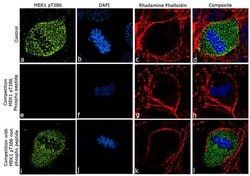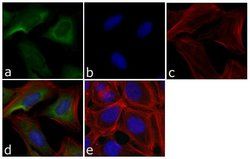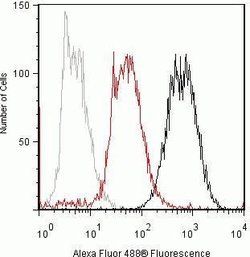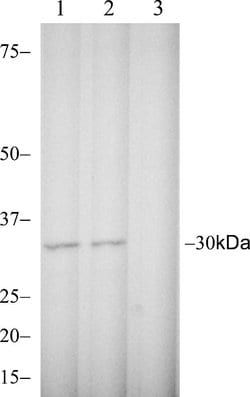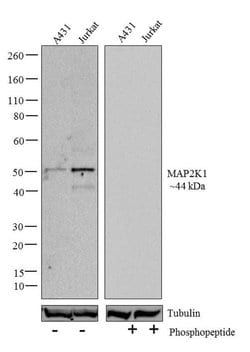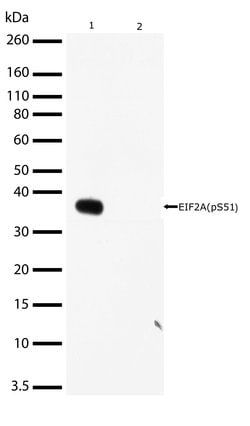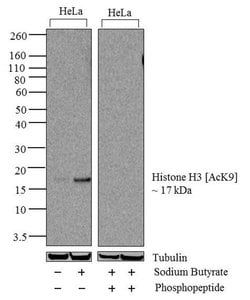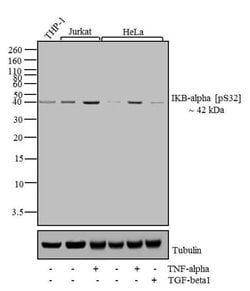Phospho-MEK1 (Ser217, Ser221) Recombinant Rabbit Monoclonal Antibody (13H22L22), Invitrogen™
Manufacturer: Thermo Scientific
Select a Size
| Pack Size | SKU | Availability | Price |
|---|---|---|---|
| Each of 1 | PI701267-Each-of-1 | In Stock | ₹ 50,596.50 |
PI701267 - Each of 1
In Stock
Quantity
1
Base Price: ₹ 50,596.50
GST (18%): ₹ 9,107.37
Total Price: ₹ 59,703.87
Antigen
Phospho-MEK1 (Ser217, Ser221)
Classification
Recombinant Monoclonal
Concentration
0.5 mg/mL
Formulation
PBS with 0.09% sodium azide
Gene Accession No.
Q02750
Gene Symbols
Map2k1
Immunogen
Phosphopeptide corresponding to amino acids 212–226 of human MAP2K1 [pSpS217/221]
Quantity
100 μg
Primary or Secondary
Primary
Target Species
Human
Product Type
Antibody
Isotype
IgG
Applications
ChIP Assay, Western Blot
Clone
13H22L22
Conjugate
Unconjugated
Gene
Map2k1
Gene Alias
CFC3; dual specificity mitogen activated protein kinase kinase 1; dual specificity mitogen-activated protein kinase kinase 1; EC 2.7.12.2; ERK activator kinase 1; kinase MEK1; MAP kinase kinase 1; MAP kinase kinase or Erk Kinase, Dual specificity mitogen-activated protein kinase kinase, involved in ras mediated vulval induction, LEThal LET-537 (42.8 kD) (mek-2); MAP kinase/Erk kinase 1; Map2k1; map2k1.L; MAPK/ERK kinase 1; MAPKK 1; MAPKK1; MEK 1; Mek1; MEK2; mek-2; MEKK1; mitogen activated protein kinase kinase 1; mitogen-activated protein kinase kinase 1; mitogen-activated protein kinase kinase 1 L homeolog; MKK (Thr292); MKK (Thr386); MKK1; MKK2; MP2K1; Prkmk1; PRKMK2; protein kinase, mitogen activated, kinase 1, p45; protein kinase, mitogen-activated, kinase 1 (MAP kinase kinase 1); XELAEV_18018447mg
Host Species
Rabbit
Purification Method
Protein A
Regulatory Status
RUO
Gene ID (Entrez)
5604
Content And Storage
Store at 4°C short term. For long term storage, store at -20°C, avoiding freeze/thaw cycles.
Form
Liquid
Related Products
Description
- This antibody is predicted to react with mouse, rat, Drosophila, non-human primate and rabbit based on sequence homology
- Intact IgG appears on a non-reducing gel as ∽150 kDa band and upon reduction generating a ∽25 kDa light chain band and a ∽50 kDa heavy chain
- Recombinant rabbit monoclonal antibodies are produced using in vitro expression systems
- The expression systems are developed by cloning in the specific antibody DNA sequences from immunoreactive rabbits
- Then, individual clones are screened to select the best candidates for production
- The advantages of using recombinant rabbit monoclonal antibodies include: better specificity and sensitivity, lot-to-lot consistency, animal origin-free formulations, and broader immunoreactivity to diverse targets due to larger rabbit immune repertoire
- MAP2K1 (MEK1) kinase is a dual-specificity protein kinase that functions in mitogen-activated protein kinase (MAPK) cascades, controlling cell growth and differentiation
- MAP2K1 is activated by a wide variety of growth factors and cytokines and also by membrane-dependent depolarization and calcium influx
- Mek1 is activated by phosphorylation of serine 218 and 222 residues by Raf1
- It is known to be involved in the signaling during stress activate response, apoptosis and proliferative induction by cytokines
- Mutations in the gene can lead to cardiofaciocutaneous syndrome.
